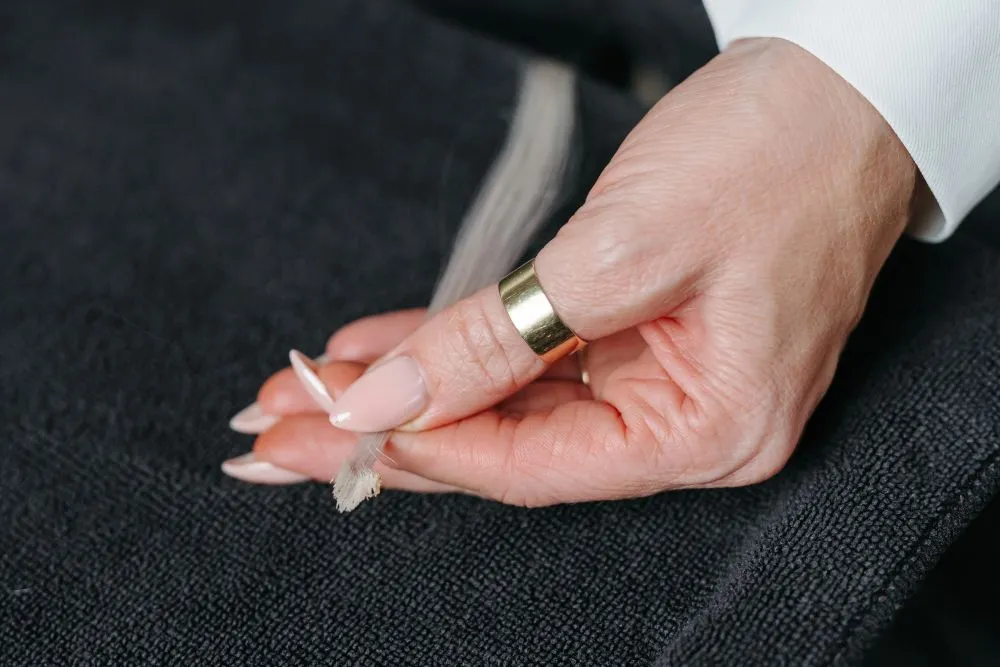Micro K-Tips vs Traditional Extensions: Discover the Benefits

As the demand for seamless, damage-minimizing hair enhancements grows, micro K-Tip extensions have emerged as a modern alternative to traditional methods. These extensions use a small, bead-based attachment system that blends naturally with the client’s own hair while minimizing strain on the scalp and hair follicles. Unlike older techniques, such as sew-in, clip-ins, or tape-in extensions, that can create tension, buildup, or long-term damage, micro K-Tips are designed to distribute weight more evenly and reduce mechanical stress.
This comparison explores the key differences between Micro K-Tip extensions and traditional hair extension techniques. Whether you’re a professional stylist or someone researching the best extension type for your hair goals, this guide will help you understand why micro K-Tip extensions are becoming the go-to choice for safe, long-lasting hair volume and length.
Key Takeaways
- Micro K-Tip extensions use a bead-based attachment system that reduces hair breakage.
- They evenly distribute weight, lessening scalp tension compared to adhesive methods.
- Clients report improved comfort and natural appearance over extended periods.
- Long-term maintenance costs are lower due to fewer reapplications.
- Professional studies and real-world feedback support the advantages of micro K-Tip extensions.
Define Micro K-Tip Extensions and Traditional Hair Techniques

Hair extensions have evolved significantly, offering more refined techniques to meet diverse styling needs and hair health concerns. Among the most notable advancements is the rise of Micro K-Tip extensions—a modern, low-damage solution that contrasts sharply with older, more invasive methods. To fully understand their benefits, it's essential first to explore how Micro K-Tip extensions work and how they differ from traditional techniques still used in many salons today.
What Are Micro K-Tip Extensions?
Micro K-Tip extensions use a small bead-based attachment system to bond extension strands to natural hair without adhesives or sewing. Each strand is attached using a medical-grade silicone or lightweight metal micro bead, clamped gently to the client’s hair. The extensions are typically made from 100% human Remy hair and often infused with keratin to maintain natural texture, strength, and durability. This technique allows for a lightweight, discreet bond that minimizes tension on the scalp and reduces the risk of breakage—ideal for clients looking for a low-damage, long-term solution.
How Do Traditional Hair Extension Methods Work?
Traditional methods include adhesive bonding, sewing, and clip-ins. Adhesive systems use chemical-based glues or tapes to secure extensions directly to the hair shaft, which may cause buildup and potential irritation over time. Sew-in techniques involve braiding natural hair and stitching extensions onto the braids, creating tight tension points and mechanical stress on the roots. While these methods can deliver volume and length, they often require more frequent maintenance and may pose long-term risks to scalp and hair health if not properly managed.
Compare Attachment Methods and Integration With Natural Hair

The way hair extensions are attached plays a major role in their comfort, durability, and long-term impact on natural hair health. Micro K-Tip extensions and traditional methods differ significantly in how they bond to the hair, how stress is distributed, and how naturally the extensions blend with existing strands. Understanding these differences can help both clients and stylists make informed decisions based on hair type, lifestyle, and desired maintenance level.
Bead-Based Integration: How Micro K-Tip Extensions Work
Micro K-Tip extensions use a precise, bead-based system that attaches each extension strand to a small section of natural hair. These micro beads—crafted from medical-grade silicone or lightweight metal—are clamped securely without heat or glue. Because the beads are small and installed across multiple points on the scalp, they distribute weight evenly and reduce localized pressure. This approach protects the hair shaft from breakage and allows for natural movement and a seamless, undetectable finish. The result is a secure hold that blends effortlessly with the client’s hair while minimizing long-term damage.
Traditional Attachment Methods: Adhesives and Mechanical Links
In contrast, traditional hair extension methods rely on adhesives, weaving, or sewing. Adhesive techniques use chemical-based glues or bonding strips that attach directly to the hair shaft, which can lead to residue buildup, irritation, and long-term weakening of natural hair. Mechanical methods like sewing or weaving involve braiding sections of the natural hair and stitching wefts into the braids, creating concentrated tension points. These techniques can cause mechanical stress, scalp discomfort, and, in some cases, traction-related thinning if worn for extended periods without proper maintenance.
Evaluate the Impact on Natural Hair and Scalability of Use

One of the most important factors when selecting an extension method is the long-term health of natural hair. Micro K-Tip extensions are specifically designed to minimize tension, reduce mechanical stress, and preserve the integrity of the scalp and hair follicles. In contrast, many traditional extension techniques apply concentrated force or harsh chemicals that may compromise the health and density of natural hair over time.
How Micro K-Tip's Lightweight Design Protects Hair Integrity
Micro K-Tip extensions are engineered to be lightweight and evenly distributed, thanks to the small, flexible micro beads used during installation. This design prevents excessive strain at the root level and avoids pulling on the scalp. Unlike heavier systems that stretch or weaken hair follicles, potentially causing thinning or even traction alopecia, Micro K-Tips maintain the hair’s natural density and reduce the risk of long-term damage. Clients frequently report less scalp discomfort, reduced shedding, and better hair strength after consistent use. Stylists also note that the lightweight design allows for extended wear without frequent adjustments, improving both comfort and convenience.
Mechanical Stress in Traditional Methods
Traditional extensions—particularly adhesive, sewn-in, or braided techniques—often exert uneven mechanical stress on specific areas of the scalp. Adhesives can burden the hair shaft with both chemical compounds and added weight, which may lead to breakage or allergic reactions. Similarly, weaving and sewing extensions into tight braids concentrate tension along the hairline or crown, increasing the likelihood of stress-related damage. Over time, this stress can cause thinning, localized breakage, and in severe cases, permanent hair loss.
Clients transitioning from traditional methods to Micro K-Tip systems often report noticeable improvements in hair texture, manageability, and volume. Stylists emphasize that the microbead system helps preserve long-term hair health by distributing pressure evenly and avoiding the high-tension points common in traditional techniques.
Assess Longevity and Durability in Daily Wear

Durability plays a crucial role in the overall value of any hair extension system. Clients and stylists alike look for extensions that maintain their appearance through daily styling and minimize the need for frequent touch-ups. Micro K-Tip extensions offer long-lasting performance thanks to their secure attachment method and high-quality materials. Compared to traditional extension systems, they deliver superior resistance to wear and better retention over time.
Performance of Micro K-Tip Extensions Over Time
Micro K-Tip extensions are built with durability in mind. The micro beads—crafted from corrosion-resistant silicone or lightweight metal—hold securely through daily brushing, heat styling, and regular washing. Unlike adhesives that weaken with repeated shampooing or exposure to styling products, Micro K-Tips maintain their bond without relying on chemical agents. With proper care, clients can expect these extensions to retain their hold for 8 to 12 weeks, offering a longer maintenance window than most traditional alternatives.
Stylists frequently report that Micro K-Tips maintain over 90% of their initial hold strength even after several weeks of wear. This durability translates to fewer salon visits and more predictable upkeep, making them a practical and cost-effective choice for long-term use.
Wear and Damage Accumulation in Traditional Methods
Traditional hair extensions—such as tape-ins, glue-ins, or sew-ins—are more prone to deterioration over time. Adhesive bonds can break down with heat, moisture, and chemical exposure, leading to slippage and buildup at the roots. Similarly, sewing techniques place stress at fixed points, which may cause breakage or thinning in those areas with repeated installation cycles.
Over time, this cumulative stress not only affects the extensions but can also degrade the health and texture of the natural hair. Frequent reapplication sessions, product-heavy maintenance routines, and improper removal techniques further increase the risk of long-term damage. In contrast, Micro K-Tip extensions' gentle yet durable structure minimizes this wear and supports the longevity of both the extension hair and the client’s natural strands.
Weigh Financial Investment Against Long-Term Value

Choosing the correct type of hair extension isn’t just about initial appearance—it’s also about long-term performance, maintenance requirements, and the overall value it provides over time. While traditional methods often have lower upfront costs, they require more frequent upkeep and may lead to additional expenses tied to hair damage or removal. Micro K-Tip extensions, made with 100% human Remy hair and bonded using a damage-reducing bead system, offer a higher return on investment through greater longevity, fewer reapplications, and better preservation of natural hair health.
Initial Costs vs. Maintenance Frequency
Micro K-Tip extensions typically come with a higher initial installation cost due to the use of premium materials, like 100% human Remy hair, and the precision required during application. However, they require significantly less maintenance than traditional systems. While glue-in, tape-in, or sewn-in methods may need reapplication every 4 to 6 weeks, Micro K-Tips can last between 8 to 12 weeks with proper care. This extended wear cycle reduces the number of salon visits, saving time and money in the long run.
Predictable Upkeep and Fewer Complications
Traditional extensions often involve unexpected expenses, such as scalp irritation treatments, adhesive residue removal, or repairs due to bond failure. These complications can add to the actual cost of maintaining the style. In contrast, Micro K-Tip extensions offer predictable upkeep and lower risk of complications. Because they bond securely without glue or tension-based methods, they are less likely to cause issues that demand corrective treatment or emergency maintenance.
Total Value Over Time
When factoring in installation, upkeep, and the impact on natural hair health, Micro K-Tip extensions present a more cost-effective solution over time. Their long-lasting hold, gentle application method, and use of high-quality human Remy hair ensure the extensions remain natural-looking and secure through weeks of daily wear. Clients benefit from reduced long-term costs and fewer touch-ups, while stylists appreciate the reliable performance and client satisfaction that Micro K-Tips consistently deliver.
Conclusion
Micro K-Tip extensions represent a clear evolution in hair enhancement, prioritizing aesthetics and natural hair's long-term health. Their secure, lightweight bead-based system—combined with 100% human Remy hair—offers a natural appearance, extended wear time, and significantly less damage than traditional methods like adhesives, sewing, or weaving.
While the upfront cost may be higher, the long-term value is unmatched. Clients benefit from fewer salon visits, predictable maintenance, and improved scalp comfort, while stylists appreciate the consistent results and minimal risk of complications. As the demand for safe, durable, and natural-looking hair extensions grows, Micro K-Tip systems continue to set a new standard in premium hair care.
Frequently Asked Questions
What makes Micro K-Tip extensions different from adhesive methods?
Micro K-Tip extensions use tiny, lightweight beads to attach extensions without glue or chemicals. This reduces the risk of residue buildup, irritation, and hair damage—common issues with adhesive-based systems.
How long do Micro K-Tip extensions typically last?
With proper care, Micro K-Tip extensions can last 8 to 12 weeks between maintenance appointments—longer than most traditional systems, which often require touch-ups every 4 to 6 weeks.
Are Micro K-Tip extensions safe for thinning or sensitive hair?
Yes. Because the beads distribute weight evenly and avoid harsh adhesives or tight braiding, they are well-suited for clients with fine, thinning, or sensitive hair.
What type of hair is used in Micro K-Tip extensions?
High-quality Micro K-Tip extensions are made from 100% human Remy hair, offering the most natural look, feel, and styling versatility.
Is maintenance more affordable over time?
Absolutely. While installation costs may be higher initially, Micro K-Tip extensions require fewer reapplications and reduce the risk of damage, leading to lower overall maintenance expenses.
Can Micro K-Tip extensions be reused?
Yes. If properly removed and maintained, the extensions can often be reapplied, making them a more sustainable and cost-effective choice over time.